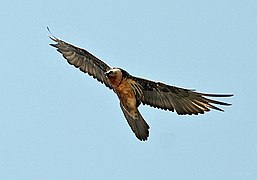Lammergeier (Gypaetus barbatus)
It’s hard to imagine a more unusual diet for any bird anywhere than the Lammergeier’s. Believe it or not, up to 85% of its food consists of nothing more than bones, hardly the most appetising prospect, it would seem, for any living creature. But, armed with a powerful digestive system featuring high levels of acid in the stomach, this very large vulture manages to eke out a living. Even so, it is a rare bird in Europe, being found only in the Pyrenees and some high mountains in Greece.

By Richard Bartz, Munich aka Makro Freak – Own work, CC BY-SA 2.5, https://commons.wikimedia.org/w/index.php?curid=2888498
Being such a specialist, the Lammergeier doesn’t need to get involved in any unseemly scrums with other vultures at a carcass. It can simply wait until they have finished, and take away the rest, which might include skin and fur as well as the skeleton. The only other potential competition would be with another Lammergeier, but these birds have such enormous home ranges (often over 1000km²) that they probably don’t meet very often. In the Pyrenees, nests are on average about 11km apart, giving everyone plenty of room.

J.M.Garg, CC BY-SA 3.0 <https://creativecommons.org/licenses/by-sa/3.0>, via Wikimedia Commons
Lammergeiers will take all kinds of carcass, large and small, but obviously a grazing mammal, such as a sheep or chamois, will provide the most profit. There is a problem with such a prize, though, and that is that the leg bones might be too long to swallow, and the delicious marrow inside will be hard to get at. But the solution is simple; the Lammergeier simply carries the offending bone to a height somewhere above 20m, and drops it on to some suitable rocks below, smashing it open. Favoured dropping areas, called ossuaries, can become littered with bones.
The Lammergeier doesn’t take much live prey, but unfortunately the bone dropping method does translate rather well to tortoises. These unfortunate animals are dashed to their death and swallowed, shell, flesh and all.
From ‘Birds: A Complete Guide to All British and European Species’, by Dominic Couzens. Published by Collins and reproduced with permission.
